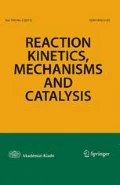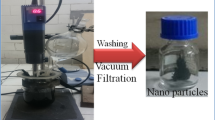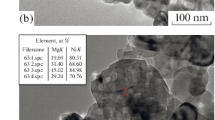Abstract
The endothermic reaction of the fuel is used as a cooling system for hypersonic aircraft. At this time, the zeolite catalyst is used for an effective endothermic reaction. In this work, the effect of metal foam catalyst on the composition of the product was investigated by using zeolite with a metal foam support as a catalyst for the endothermic reaction. The metal foam support was made with NiCrAl alloy. The characteristics of the zeolite catalyst were confirmed by X-ray diffraction (XRD) analysis, Fourier transform infrared spectroscopy (FT-IR) analysis and NH3-Temperature programmed desorption (NH3-TPD) analysis. The composition of the product of the endothermic reaction was analyzed by GC–MS. In experiments of H-ZSM-5 catalyst pellet, the conversion of methylcyclohexane (MCH) was about 82%. While, in the case of the H-ZSM-5 catalyst supported with the metal foam, the conversion of MCH was about 93% and the conversion was 11% higher than that of the zeolite catalyst itself. In addition, experimental results with different temperatures showed that MCH conversion and aromatic hydrocarbon increased with increasing temperature. On the other hand, low hydrocarbons increased when increasing from 598 to 633 K, but decreased when increasing to 673 K.








Similar content being viewed by others
References
Sicard M, Grill M, Raepsaet B, Ser F (2008) Comparison between thermal and catalytic cracking of a model endothermic fuel. AIAA-2008-2622
Petley DH, Jones SC (1992) Thermal management for a Mach 5 cruise aircraft using endothermic fuel. J Aircraft 29(3):384–389
Huang H, Sobel DR, Spadaccini LJ (2002) Endothermic heat-sink of hydrocarbon fuels for SCRAMJET cooling. AIAA-2002-3871
Sicard M, Raepsaet B, Ser F, Masson C (2005) Determination of the decomposition products of a n-alkane endothermic fuel under supercritical conditions. AIAA-2005-3402
Fan XJ, Zhong FQ, Yu G, Li JG, Sung CJ (2009) Catalytic cracking and heat sink capacity of aviation kerosene under supercritical conditions. J Propuls Power 25(6):1226–1232
Edwards T (2006) Cracking and deposition behavior of supercritical hydrocarbon aviation fuels. Combust Sci Techol 178:307–334
Kim JY, Park SH, Chun BH, Jeong BH, Han JS, Kim SH (2012) Improvement of the heats of reaction in endothermic reactions of methylcyclohexane with zeolites. Catal Today 185:47–53
Huang B, Bai P, Neurock M, Davis RJ (2017) Conversion of n-hexane and n-dodecane over H-ZSM-5, HY and Al-MCM-41 at supercritical conditions. Appl Catal A Gen 546:149–158
Lander H, Nixon AC (1971) Endothermic fuels for hypersonic vehicles. J Aircraft 8(4):200–207
Wan Z, Li GK, Wang CF, Yang H, Zhang DK (2018) Relating coke formation and characteristics to deactivation of ZSM-5 zeolite in methanol to gasoline conversion. Appl Catal A Gen 549:141–151
Lee KH, Lee SH, Jun YS, Choi MK (2017) Cooperative effects of zeolite mesoporosity and defect sites on the amount and location of coke formation and its consequence in deactivation. J Catal 347:222–230
Maurice LQ, Edwards T, Griffiths J (2001) Liquid hydrocarbon fuels for hypersonic propulsion. Scramjet Propuls 189:757–822
Usman MR, Cresswell DL, Garforth AA (2010) Kinetics of methylcyclohexane dehydrogenation and reactor simulation for “On-board” hydrogen storage. Thesis submitted to The University of Manchester for the degree of Doctor of Philosophy, p. 139
Moljord K, Magnoux P, Guisnet M (1995) Coking, aging and regeneration of zeolites XVI. Influence of the composition of HY zeolites on the removal of coke through oxidative treatment. Appl Catal A Gen 121(2):245–259
Qu S, Liu G, Meng F, Wang L, Zhang X (2011) Catalytic cracking of supercritical n-dodecane over wall-coated HZSM-5 with different Si/Al ratio. Energy Fuels 25:2808–2814
Qiu Y, Hou X, Liu G, Wang L, Zhang X (2017) Fast recovery of Brønsted acid sites lost during high-temperature calcination in HZSM-5. Microporous Mesoporous Mater 243:176–185
Acknowledgements
This study was conducted as part of the Basic Research Project (Pure-17-20) of Defense Acquisition Program Administration.
Author information
Authors and Affiliations
Corresponding author
Additional information
Publisher's Note
Springer Nature remains neutral with regard to jurisdictional claims in published maps and institutional affiliations.
Rights and permissions
About this article
Cite this article
Shin, M.C., Moon, J.I., Jung, J.H. et al. Decomposition reaction of methylcyclohexane using H-ZSM-5 supported on NiCrAl metal foam. Reac Kinet Mech Cat 126, 761–772 (2019). https://doi.org/10.1007/s11144-018-1514-x
Received:
Accepted:
Published:
Issue Date:
DOI: https://doi.org/10.1007/s11144-018-1514-x




